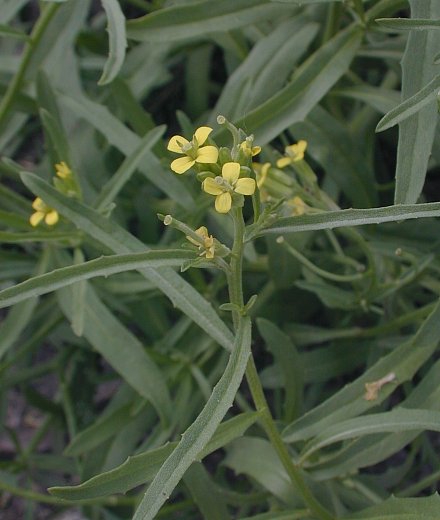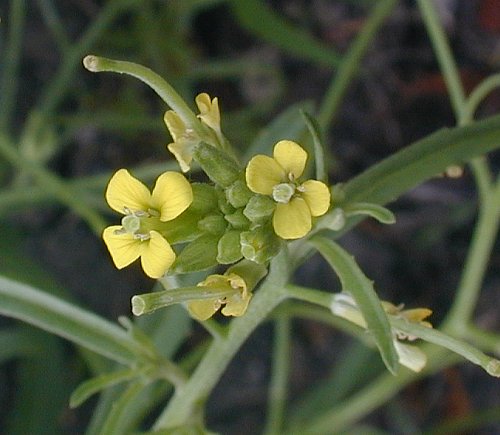Description: This plant is a winter annual that becomes 1-2' tall, branching occasionally. The variable stems are round, angular, or ridged; they are rather stout and have short appressed hairs. The basal leaves form a low rosette spanning about 6" across. They are broadly linear (usually broadest toward the middle), and dentate with widely spaced teeth or shallowly lobed along the margins. Like the stems, they have short appressed hairs. The cauline leaves alternate along the stems. They are similar to the basal leaves, although less likely to be lobed, and span up to 3" in length and 2/3" (17 mm.) across. Sometimes the leaves have a shiny upper surface and their margins are curly or undulate.

The upper stems terminate in racemes of flowers. Each flower is about ¼" across when fully open and about 1/3" (8 mm.) long. It consists of 4 petals that are yellow or bicolored (white near the throat of the flower, yellow toward the tips of the petals), 4 green sepals that are linear-lanceolate, and several stamens with dull brown anthers, and a pistil with a stout style. The petals are longer than sepals, and they become very narrow toward the base of the flower. The mature pedicel of each flower becomes about 1/3" (8 mm.) long and it is quite stout. The blooming period occurs from mid-spring to early summer and lasts about 1-2 months. Each flower is replaced by a silique (slender seedpod) that is 2-4" long when fully mature and cylindrical in shape. This silique may be angular or round in cross-section. The siliques are widely spreading to ascending and almost resemble slender stems. The small seeds are oblongoid and brown. The root system consists of a taproot that is often stout. This plant spreads by reseeding itself.

Cultivation:
This
adaptable plant prefers full sun, slightly moist to dry-mesic
conditions, and
tolerates different kinds of soil; it often occurs in fertile loam or
clay loam. Most vegetative growth occurs during the spring.
Range & Habitat:
The adventive Treacle Mustard occurs occasionally in scattered counties
throughout
Illinois (see Distribution
Map). It may be locally common in some areas. Habitats
include fields, construction sites, vacant lots, areas along railroads
and roadsides, and miscellaneous waste areas. It prefers areas where
the soil has been recently disturbed and competition from other ground
vegetation has been reduced. Treacle Mustard is native to
Eurasia.

Faunal
Associations:
The flowers probably attract various kinds of small bees, flies, and
White butterflies, like other members of the Mustard family. Several
leaf beetles feed on foliage and/or roots of Treacle Mustard and other Erysimum
spp. This includes Entomoscelis americana
(Red Turnip Beetle), Phyllotreta cruciferae
(Crucifer Flea Beetle), Phyllotreta striolata
(Striped Flea Beetle), and Psylliodes punctulata
(Hop Flea Beetle); see Clark et al. (2004). Some Erysimum
spp., such as Erysimum cheiranthoides
(Wormseed Mustard), have bitter-tasting foliage and seeds that probably
discourage their consumption by mammalian herbivores. The foliage of
plants in the Mustard family also contains cardiac glycosides and other
compounds that are toxic to many mammalian herbivores.
Photographic Location:
Disturbed soil near a parking lot where construction activity was
taking place at the Champaign County Courthouse in Urbana, Illinois.

Comments: Other common names for this plant are 'Spreading Wallflower' and 'Bushy Wallflower.' It is in the same genus as the native Erysimum capitatum (Western Wallflower), which has much showier flowers (about ¾" across). Generally, Erysimum spp. have flowers with long narrow sepals and cylindrical siliques. The size of the flowers for this group of plants is highly variable. Treacle Mustard differs from other Erysimum spp. in Illinois by its long spreading siliques (about 2-4" in length) on short stout pedicels (about 1/3" or 8 mm. long). Other Erysimum spp. have shorter siliques (less than 2" in length) on slender pedicels; their siliques are often held more erect and closer to the central stalk of the raceme. The Western Wallflower also has long siliques (up to 4" in length), but its flowers are much larger than those of Treacle Mustard.